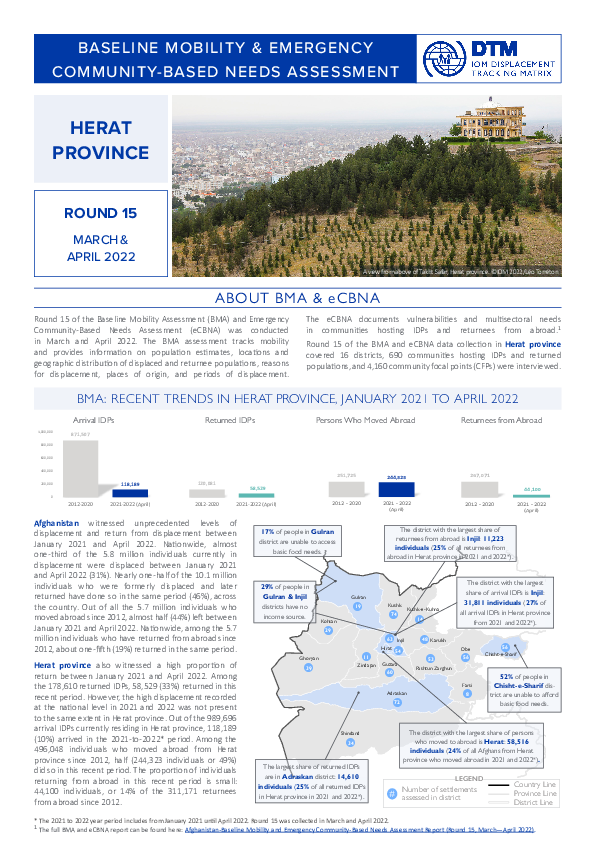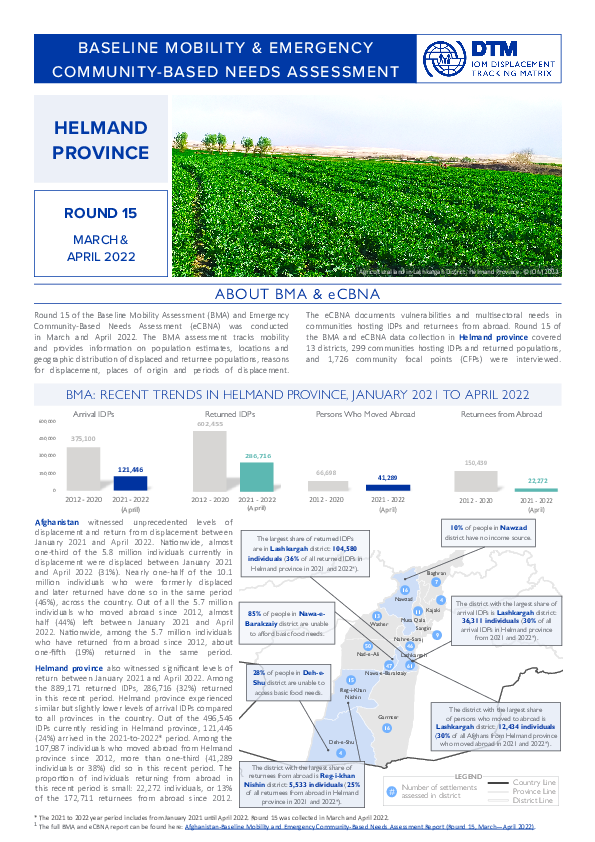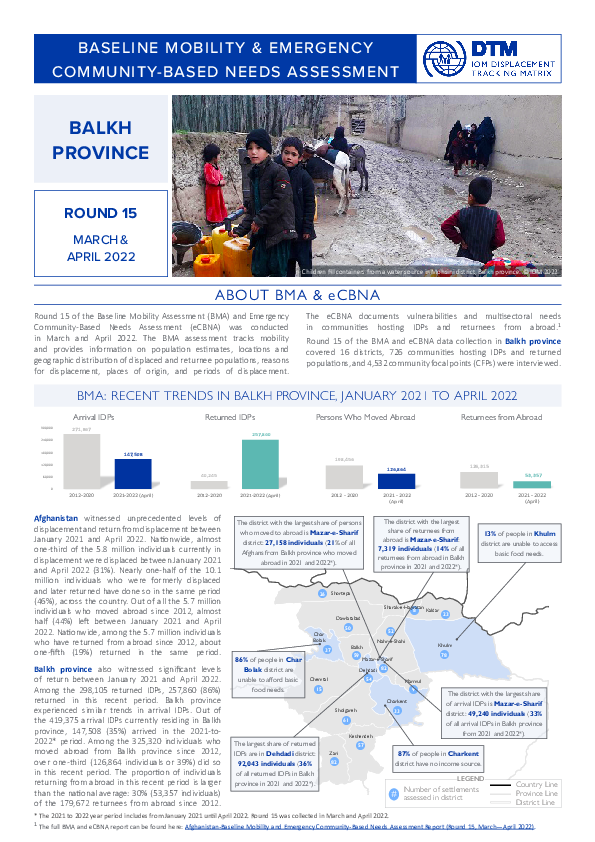-
Countries
-
Data and Analysis
-
Special Focus
-
Crisis Responses
Site Assessment
Contact
DTM Burundi, DTMBurundi@iom.int
Location
Burundi
Activity
- Mobility Tracking
- Site Assessment
Period Covered
Apr 11 2022 -May 03 2022
A site assessment is a sub-component of mobility tracking. It aims to collect data on population presence, living conditions and needs in a particular displacement site or community.
Population Groups
Survey Methodology
Unit of Analysis Or Observation
Type of Survey or Assessment
Keywords
Geographical Scope
Administrative boundaries with available data
The current dataset covers the following administrative boundaries

Contact
DTMAfghanistan@iom.int
Language
English
Location
Afghanistan
Period Covered
Mar 01 2022
Apr 30 2022
Activity
- Mobility Tracking
- Site Assessment
DTM has been conducting the Baseline Mobility Assessment in Afghanistan since 2016 to track mobility, provide information on population estimates, locations and geographic distribution of displaced and returnee populations, reasons for displacement, places of origin and periods of displacement. Vulnerabilities and multisectoral needs are covered in the Emergency Community- Based Needs Assessment (eCBNA) at the end of the report. Data is collected at the settlement level, through focus group discussions with community focal points and direct observations.
In Round 15, the DTM team witnessed a net increase in the number of all four target populations compared to the previous round (Round 14, collected in November and December 2021).
Contact
DTM Ethiopia, SLOAddisAbabaDTM@iom.int
Location
Ethiopia
Activity
- Mobility Tracking
- Site Assessment
- Village Assessment
Period Covered
Jan 10 2022 -Apr 09 2022
A village assessment survey (VAS) is a sub-component of mobility tracking. It collects data on returning IDPs, IDPs, returned migrants and host community members. VAS evaluates the absorption capacity of villages to receive returning IDPs with a focus on accessibility of services, livelihoods and reintegration.
Population Groups
Survey Methodology
Unit of Analysis Or Observation
Type of Survey or Assessment
Keywords
Geographical Scope
Administrative boundaries with available data
The current dataset covers the following administrative boundaries
Contact
DTM Ethiopia, SLOAddisAbabaDTM@iom.int
Location
Ethiopia
Activity
- Mobility Tracking
- Site Assessment
Period Covered
Mar 01 2022 -Apr 18 2022
A site assessment is a sub-component of mobility tracking. It aims to collect data on population presence, living conditions and needs in a particular displacement site or community.
Population Groups
Survey Methodology
Unit of Analysis Or Observation
Type of Survey or Assessment
Keywords
Geographical Scope
Administrative boundaries with available data
The current dataset covers the following administrative boundaries

Contact
DTM Ethiopia, SLOAddisAbabaDTM@iom.int
Language
English
Location
Ethiopia
Period Covered
Mar 01 2022
Apr 18 2022
Activity
- Mobility Tracking
- Site Assessment
- Village Assessment
In order to capture the displacement and return dynamics in Ethiopia, DTM Ethiopia's National Displacement Report combines findings from its Site Assessment (SA) in Section 1 and findings from the Village Assessment Survey (VAS) in Section 2. The Site Assessment tracks the number of internally displaced persons (IDPs), while the Village Assessment Survey tracks the number of IDPs who are returning or have returned to their communities.
As of April 2022, a total of 2.75 million IDPs have been identified in 2,158 accessible sites across 11 regions in Ethiopia. As a note, due to operational constraints, figures from Tigray region were not included in the total. Of the displaced population, the main causes of displacement were conflict which displaced 1.78 million IDPs (65%), drought which displaced 581,952 IDPs (21%), social tension which displaced 150,576 IDPs (5%), flash floods which displaced 107,816 IDPs (4%) and seasonal floods which displaced 94,118 IDPs (3%).
Through Village Assessment Survey round 12 (March-April 2022), a total of 1.66 million returning IDPs were identified in 1,403 villages across 9 regions (data collection was not undertaken in Tigray region due to a lack of fuel and cash). 1.6 million returning IDPs (97%) were initially displaced due to conflict, 22,107 returning IDPs (1%) were initially displaced due to seasonal floods, 17,178 returning IDPs due to flash floods (1%), 3,439 returning IDPs due to landslides (<1%) and 737 returning IDPs due to fire (<1%).

Contact
DTMAfghanistan@iom.int
Language
English
Location
Afghanistan
Period Covered
Mar 01 2022
Apr 30 2022
Activity
- Mobility Tracking
- Site Assessment
- Baseline Assessment
DTM has been conducting the Baseline Mobility Assessment in Afghanistan since 2016 to track mobility, provide information on population estimates, locations and geographic distribution of displaced and returnee populations, reasons for displacement, places of origin and periods of displacement. Vulnerabilities and multi-sectoral needs are covered in the Emergency Community- Based Needs Assessment (eCBNA) at the end of the report. Data is collected at the settlement level, through focus group discussions with community focal points and direct observations.
This province highlight delves into the key findings in Nangarhar province using the latest results from Round 15 of the BMA and eCBNA (conducted in March and April 2022), focusing on the 2021-to-2022 period. The full report can be found here: Baseline Mobility and Emergency Community-Based Needs Assessment Report (Round 15, March—April 2022)

Contact
DTMAfghanistan@iom.int
Language
English
Location
Afghanistan
Period Covered
Mar 01 2022
Apr 30 2022
Activity
- Mobility Tracking
- Site Assessment
- Baseline Assessment
DTM has been conducting the Baseline Mobility Assessment in Afghanistan since 2016 to track mobility, provide information on population estimates, locations and geographic distribution of displaced and returnee populations, reasons for displacement, places of origin and periods of displacement. Vulnerabilities and multi-sectoral needs are covered in the Emergency Community- Based Needs Assessment (eCBNA) at the end of the report. Data is collected at the settlement level, through focus group discussions with community focal points and direct observations.
This province highlight delves into the key findings in Herat province using the latest results from Round 15 of the BMA and eCBNA (conducted in March and April 2022), focusing on the 2021-to-2022 period. The full report can be found here: Baseline Mobility and Emergency Community-Based Needs Assessment Report (Round 15, March—April 2022)

Contact
DTMAfghanistan@iom.int
Language
English
Location
Afghanistan
Period Covered
Mar 01 2022
Apr 30 2022
Activity
- Mobility Tracking
- Site Assessment
- Baseline Assessment
DTM has been conducting the Baseline Mobility Assessment in Afghanistan since 2016 to track mobility, provide information on population estimates, locations and geographic distribution of displaced and returnee populations, reasons for displacement, places of origin and periods of displacement. Vulnerabilities and multi-sectoral needs are covered in the Emergency Community- Based Needs Assessment (eCBNA) at the end of the report. Data is collected at the settlement level, through focus group discussions with community focal points and direct observations.
This province highlight delves into the key findings in Helmand province using the latest results from Round 15 of the BMA and eCBNA (conducted in March and April 2022), focusing on the 2021-to-2022 period. The full report can be found here: Baseline Mobility and Emergency Community-Based Needs Assessment Report (Round 15, March—April 2022)

Contact
DTMAfghanistan@iom.int
Language
English
Location
Afghanistan
Period Covered
Mar 01 2022
Apr 30 2022
Activity
- Mobility Tracking
- Site Assessment
- Baseline Assessment
DTM has been conducting the Baseline Mobility Assessment in Afghanistan since 2016 to track mobility, provide information on population estimates, locations and geographic distribution of displaced and returnee populations, reasons for displacement, places of origin and periods of displacement. Vulnerabilities and multi-sectoral needs are covered in the Emergency Community- Based Needs Assessment (eCBNA) at the end of the report. Data is collected at the settlement level, through focus group discussions with community focal points and direct observations.
This province highlight delves into the key findings in Balkh province using the latest results from Round 15 of the BMA and eCBNA (conducted in March and April 2022), focusing on the 2021-to-2022 period. The full report can be found here: Baseline Mobility and Emergency Community-Based Needs Assessment Report (Round 15, March—April 2022)

Contact
DTM DRC, iomdrcdtm@iom.int
Language
French
Location
Democratic Republic of the Congo
Period Covered
Mar 26 2022
Jun 22 2022
Activity
- Registration
- Mobility Tracking
- Site Assessment
- Baseline Assessment
Cette fiche d’information présente les éléments clés tirés des résultats consolidés des opérations d’enregistrement menées par l’OIM dans neuf (9) sites de déplacement dont sept (7) sites dans le territoire de Djugu qui ont pris place entre le 26 et 31 mars et 18 juin 2022, deux (2) sites dans le territoire de Mahagi le 6 avril 2022 et un (1) site à Irumu le 22 juin 2022. Les sites concernés sont BUKUKU SALAMA, KANYAMUKIRA AMANI, KPAWA, LOKPA 1, LOKPA 2, UDRUWA, UYANDU, DJAIBA et SALAMA. Des équipes d’enquêteurs se sont rendues dans ces sites de déplacement afin de vérifier hutte par hutte la présence des ménages déplacés. Dans chaque hutte habitée, les enquêteurs ont procédé à l’enregistrement des ménages présents. Ce travail a été fait sur le terrain en collaboration avec les comités des déplacés, les gestionnaires de sites AIDES et la Commission Nationale pour les Réfugiés (CNR) dans la province de l’Ituri.
Pagination
- Previous page
- Page 36
- Next page
